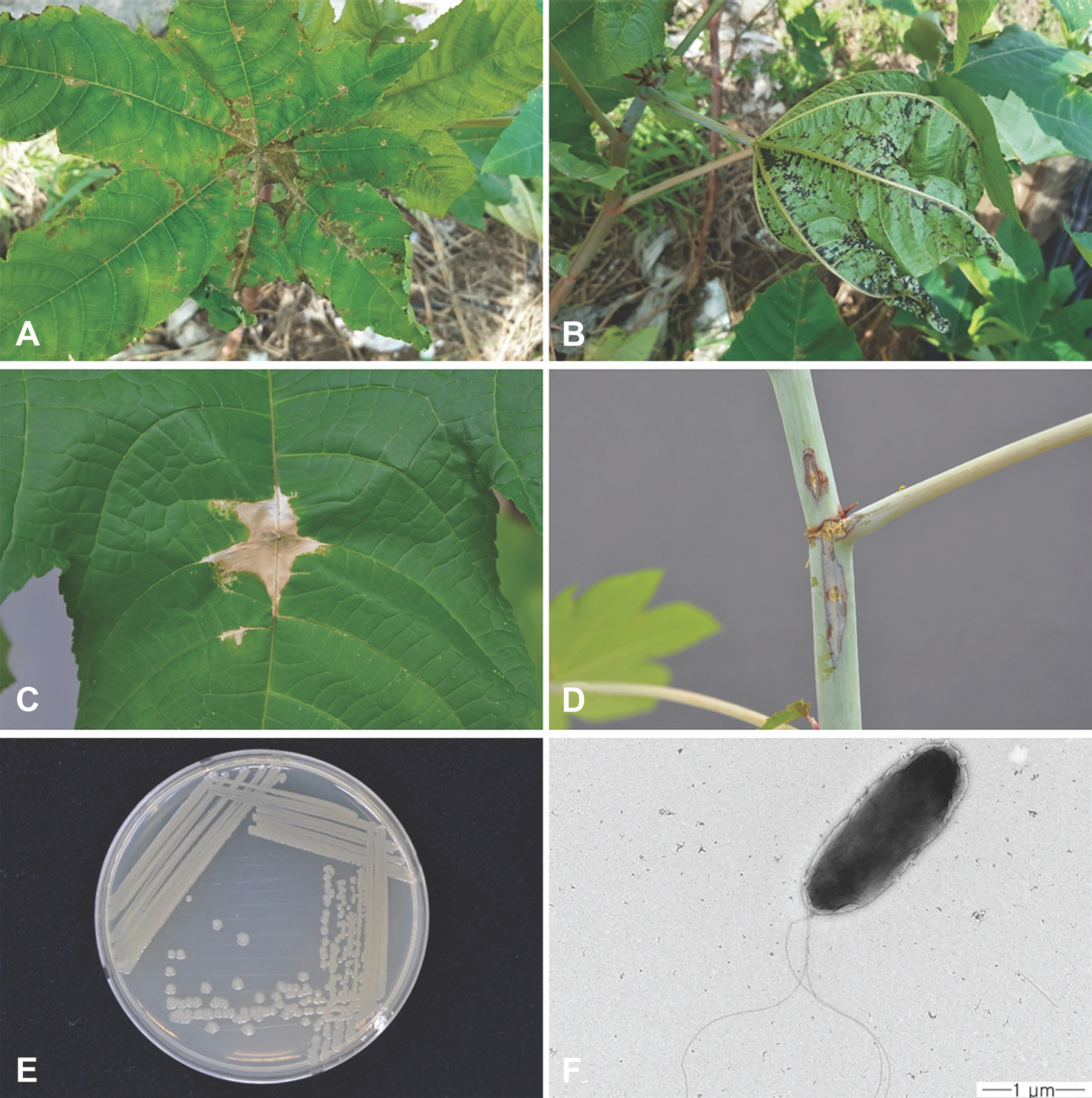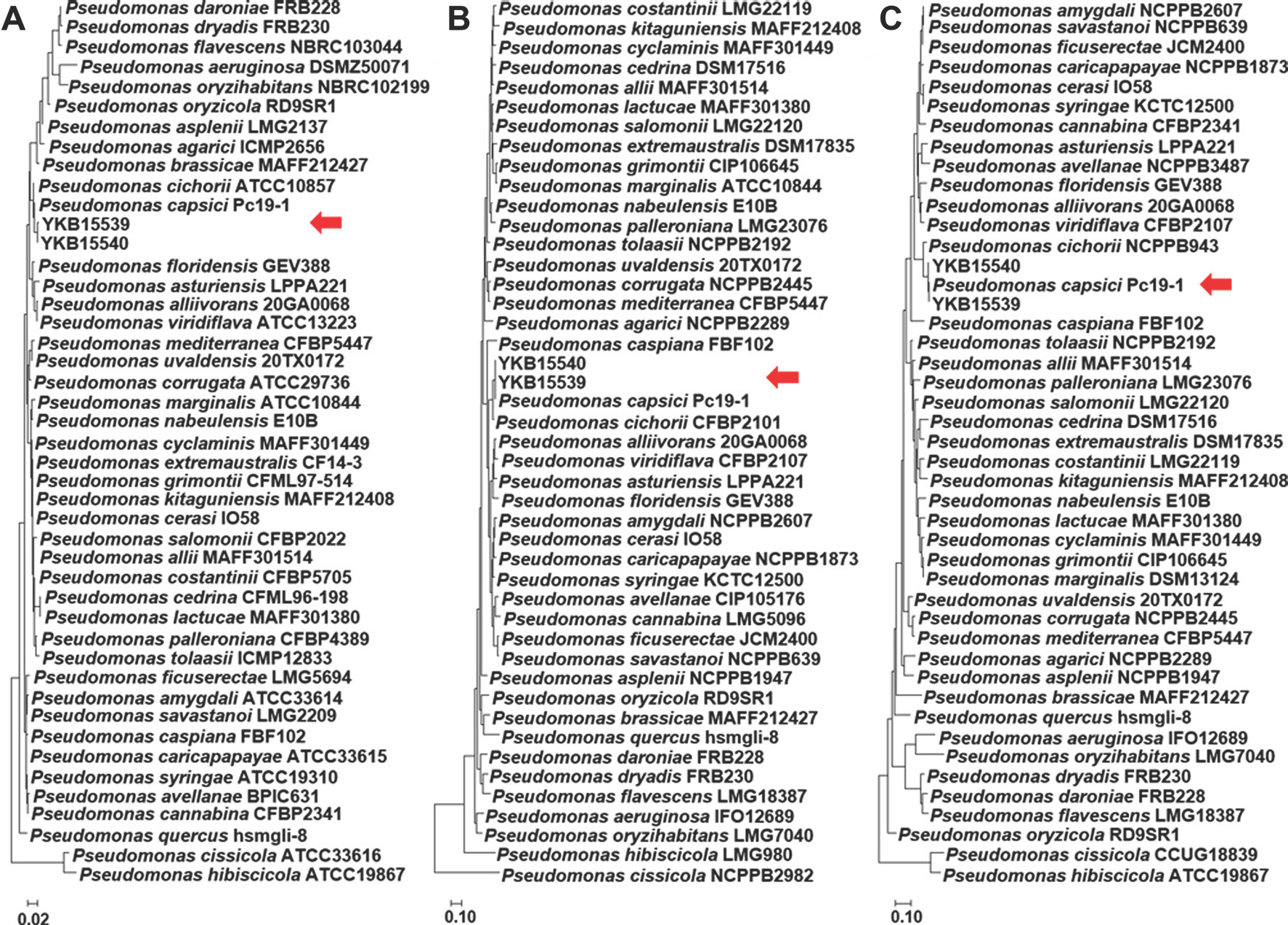아주까리 분리균은 TSA 배지에서 점액성이 없었으며, 연한 녹색을 띠는 둥근 콜로니를 형성하였다(
Fig. 1E). TSA 배지에서 28°C, 24시간 배양한 병원세균을 투과전자현미경(transmission electron microscopy, LEO 912 AB, Zeiss, Oberkochen, Germany)으로 형태를 관찰한 결과, 단극성으로 다수의 편모를 가진 막대 모양의 세균이었다(
Fig. 1F). 분리균의 생화학적 특성을 조사하기 위해 LOPAT (levan 형성, oxidase 활성, 감자 무름 반응, alginine dihydrolase 활성, 담배 과민성반응) 검정을 수행하였다(
Lelliott 등, 1966). 5% sucrose nutrient agar 배지에서 4일간 배양하여 levan 형성 여부를 조사하였으며, oxidase 활성 조사를 위해 nutrient glucose agar (beef extract 3 g, peptone 5 g, glucose 2.5 g, agar 15 g/l)에서 24시간 배양한 세균을 oxidase 활성 검사용 시약(bioMérieux, Craponne, France)에 처리하여 자주색 반응 여부를 파악하였다. 무름 반응의 조사를 위해 멸균된 칼로 표면 소독한 감자를 0.5 cm 두께로 절단한 뒤, 24시간 배양한 분리균을 절단면에 접종하였다. 접종 24시간 이후, 감자 무름 반응 여부를 조사하였다. 분리균을 arginine dihydrolase medium (peptone 1 g, NaCl 5 g, K
2 HPO
4 0.3 g, agar 3 g, phenol red 0.01 g, L-arginine HCl 10 g/l, pH 7.2)에 접종한 뒤 밀봉하였으며, 28°C에서 4일간 배양하였다. 배양 후 진한 분홍색의 변색을 조사하여 arginine dihydrolase 양성 여부를 파악하였다. 과민성 반응을 조사하기 위해 분리균을 1.0×10
7 cfu/ml 농도로 현탁하여 건전한 담배(cv. 삼선) 잎에 접종하였다. 접종 24시간 이후 과민성 반응 여부를 확인하였다. 추가적인 균학적 특성 조사를 위해 API 20 NE kit (bioMérieux)와 GEN III MicroPlate (Biolog, Hayward, CA, USA)를 이용하였으며, 세부적인 방법은 제조사의 권장 매뉴얼을 참조하였다. API 20 NE를 이용한 대사 반응 조사 결과, 분리균은 L-arabinose, capric acid, D-glucose, D-mannitol, malic acid, D-mannose, potassium gluconate와 trisodium citrate에서 양성 반응을 나타냈다. 반면, N-acetyl-glucosamine, adipic acid, D-maltose, phenylacetic acid는 음성으로 확인되었다. 아주까리 분리균은
Zhao 등(2021)이 보고한
P. capsici와
Trantas 등(2013)이 보고한
P. cichorii와 동일한 반응을 나타냈으며,
Sarris 등(2012)이 보고한
P. viridiflava와는 capric acid, malic acid 반응에서 차이가 있는 것으로 확인되었다(
Table 1). 따라서, 본 연구에서 분리된 균은
P. capsici 또는
P. cichorii로 추정되었다. LOPAT 검정 결과로 분리세균은 levan 형성 음성, oxidase 활성 양성, 감자 무름 반응 양성, arginine dihydrolase 활성 음성으로 나타났으며, 담배에서 과민성반응이 양성으로 확인되었다. 또한, GEN III microplate 검정을 통해 분리균이 α-D-glucose, D-mannose, D-fructose, D-galactose, D-fucose, inosine, D-mannitol, D-arabitol, myo-inositol, glycerol, D-aspartic acid, L-alanine, L-aspartic acid, L-glutamic acid, L-pyroglutamic acid, L-serine, D-gluconic acid, glucuronamaide, mucic acid, quinic acid, D-saccharic acid, methyl pyruvate, L-lactic acid, citric acid, α-keto-glutaric acid, D-malic acid, L-malic acid, γ-amino-butryric acid, propionic acid와 acetic acid를 물질대사에서 이용하는 것으로 확인되었고, 1% sodium lactate, fusidic acid, troleandomycin, rifamycin SV, lincomycin, guanidine HCl, niaproof 4, vancomycin, tetrazolium violet, tetrazolium blue, nalidixic acid, lithium chloride, potassium tellurite, aztreonam와 sodium bromate가 존재할 때도 생장이 가능한 것으로 나타났다(
Table 2). 본 연구에서 분리된 아주까리 세균은
Zhao 등(2021)이 보고한
P. capsici의 생화학적 특성과 일치하였다. 그러나
Timilsina 등(2018)이 보고한 감자 무름 반응,
D-fucose, troleandomycin 반응에서
P. cichorii와 차이가 났고,
P. viridiflava와도 oxidase, D-sorbitol, troleandomycin 반응이 다르게 확인되었다. 결과적으로, 분리균이
P. capsici와 동일한 균학적 특성을 가진 것으로 확인되었다.
16S rRNA 영역과 항존 유전자(
gyrB, rpoD)의 염기서열 분석은 마크로젠(Macrogen, Daejeon, Korea)에 의뢰하였다. 분석된 염기서열은 National Center for Biotechnology In-formation (NCBI) GenBank에 등록되어있는
Pseudomonas 속의 유전자 정보를 참고하여 상동성을 비교하였다. 계통도는 MEGA X 프로그램을 사용하여 maximum likelihood 를 통해 작성하였으며(
Guindon 등, 2010), 통계적 유의성은 1,000 반복의 bootstrap을 수행하여 확인하였다(
Kumar 등, 2018). GenBank에 등록된
Pseudomonas속의 식물병원세균과 분리균(YKB15539, YKB15540)의 16S rRNA 영역의 염기서열과 계통학적 연관성을 비교한 결과,
P. capsici Pc19-1
T과 같은 그룹(clade)으로 형성되는 것으로 확인되었다(
Fig. 2A). 항존유전자(
gyrB, rpoD)의 유연관계도에서도
P. capsici와 가장 높은 상동성을 나타냈다(
Fig. 2B,
C). 16S rRNA 영역과 항존유전자의 염기서열 분석 결과를 바탕으로 아주까리 분리균은
P. capsici로 확인되었다. 최종적으로, 분리세균은 병원성 검정, 균학적, 유전적 특성에 근거하여,
P. capsici로 동정되었다.
P. capsici의 경우 미국에서 고추(
Cap-sicum annuum)의 잎에서 수침성 점무늬와 괴사를 일으키는 것으로 보고되었으나(
Zhao 등, 2021), 국내에서는 보고된 바 없다. 따라서 국내 아주까리에서
P. capsici에 의한 점무늬병을 처음 보고하고자 한다.





 PDF Links
PDF Links PubReader
PubReader ePub Link
ePub Link Full text via DOI
Full text via DOI Download Citation
Download Citation Print
Print






